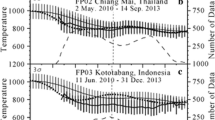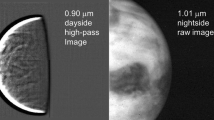Abstract
The site selection for the Iranian National Observatory (INO) was concluded in 2007. As a result of a 7-year campaign, Mount Gargash was identified to host the INO observing facilities. To measure the atmospheric seeing, an Automated Differential Image Motion Monitoring (automatic DIMM) system has been installed few 100 meters to the mainpeak. Together with a weather station, this automatic DIMM system enabled us to continuously gather data on the main atmospheric features of the site namely seeing, temperature, wind speed and direction, and relative humidity. In this study, we present the analysis of three years of automatic DIMM seeing data of this INO site. The measurements indicate that the site benefits from a low atmospheric seeing with median 0.7 arcsec and 1st and 3rd quartile being equal to 0.4 and 0.8 arcsec, respectively. We study the effect of the target position on the seeing measurements in order to optimize the future target selection criteria. Combining the simultaneous seeing and weather data, we investigate the long-term pattern of the variations in seeing and the meteorological parameters. This helps us understand the nature of variations and how they are influenced by general meteorological conditions. These analyses would improve observation strategies at this site in long and short-term.










Similar content being viewed by others
Notes
According to Dawes’ limit R = 11.6/D D in centimeters, R in arcseconds, the minimum aperture needed to reach 0.1 arcsec in resolving power of the telescope would be 116 centimeters. The median of our seeing is 0.68 arcsec, so seeing would not be important if we have the aperture of 190 mm.
There is an exception according to the magnitude of the star observed. For bright sources (e.g. Vega) the frequency of exposure time is reduced to \(\frac {1}{60}\) seconds.
We use Astelco NTM 500 DIMM seeing measurement facility, upgraded in-house for an automatic/remote operation.
References
Azouit, M., Vernin, J.: Remote Investigation of Tropospheric Turbulence by Two-Dimensional Analysis of Stellar Scintillation, 1980. ISSN 0022-4928. http://journals.ametsoc.org/doi/abs/10.1175/1520-0469
Fried, D.L.: Statistics of a geometric representation of wavefront distortion. J. Opt. Soc. Am. 55(11), 1427 (1965). ISSN 0030-3941. https://doi.org/10.1364/JOSA.55.001427
Khosroshahi, H.G., Danesh, A., Molaeinezhad, A.: Iranian national observatory. In: Proceedings of Armenian-Iranian Astronomical Workshop (AIAW). https://ui.adsabs.harvard.edu/?#abs/2016aiaw.conf...22K, p 22 (2016)
Martin, F., Tokovinin, A., Agabi, A., Borgnino, J., Ziad, A.: G.S.M.: A grating scale monitor for atmospheric turbulence measurements. I. The instrument and first results of angle of arrival measurements. Astron. Astrophys., Suppl. Ser. 108, 173–180 (1994)
Martin, H.M.: Image motion as a measure of seeing quality. Publ. Astron. Soc. Pac. 99(622), 1360–1370 (1987). ISSN 0004-6280. https://doi.org/10.1086/132126. http://iopscience.iop.org/article/10.1086/132126
Persson, S.E., Carr, D.M., Jacobs, J.H.: Las campanas observatory seeing measurements. Exp. Astron. 1(3), 195–212 (1990). ISSN 09226435. https://doi.org/10.1007/BF00462040
Roddier, C.: Measurements of the atmospheric attenuation of the spectral components of astronomical images. J. Opt. Soc. Am. 66(5), 478–482 (1976). https://doi.org/10.1364/JOSA.66.000478. http://www.osapublishing.org/abstract.cfm?URI=josa-66-5-478
Roddier, F.: The effects of atmospheric turbulence in optical astronomy. Prog. Opt. 19(C), 281–376 (1981). ISSN 00796638. https://doi.org/10.1016/S0079-6638(08)70204-X. http://www.sciencedirect.com/science/article/pii/S007966380870204X
Rösch, J., Courtés, G., Dommanget, J.: Avant-Propos. Bulletin Astronomique 24, 87–89 (1964)
Sarazin, M., Roddier, F.: The ESO differential image motion monitor. Astron. Astrophys. 227, 294–300 (1990). ISSN 0004-6361
Stock, J., Keller, G.: Astronomical Seeing, p 138. University of Chicago Press, Chicago (1961)
Tokovinin, A.: From differential image motion to seeing. Publ. Astron. Soc. Pac. 114(800), 1156–1166 (2002). ISSN 0004-6280. https://doi.org/10.1086/342683. http://iopscience.iop.org/article/10.1086/342683
Védrenne, N., Michau, V., Robert, C., Conan, J.-M.: Cn2 profile measurement from shack-hartmann data. Opt. Lett. 32(18), 2659–2661 (2007). https://doi.org/10.1364/OL.32.002659. http://ol.osa.org/abstract.cfm?URI=ol-32-18-2659
Vernin, J., Munoz-Tunon, C.: Measuring astronomical seeing: the DA/IAC DIMM. Publ. Astron. Soc. Pac. 107, 265–272 (1995). ISSN 0004-6280. https://doi.org/10.1086/133549. http://ads.nao.ac.jp/abs/1995PASP..107..265V
Acknowledgements
This research was supported by Iranian National Observatory (INO) and School Of Astronomy (SoA) at the Institute for Research in Fundamental Sciences (IPM). We thank the INO and SoA staff for providing support, insight and expertise that greatly assisted this research. We especially thank Mr. Alireza Behnam, the INO site manager, for the assistance and support he provided during this research.
Author information
Authors and Affiliations
Corresponding author
Additional information
Publisher’s note
Springer Nature remains neutral with regard to jurisdictional claims in published maps and institutional affiliations.
Rights and permissions
About this article
Cite this article
Danesh, A., Khosroshahi, H.G., Javanmardi, B. et al. Iranian national observatory project: seeing measurements at mount Gargash. Exp Astron 47, 145–160 (2019). https://doi.org/10.1007/s10686-019-09621-3
Received:
Accepted:
Published:
Issue Date:
DOI: https://doi.org/10.1007/s10686-019-09621-3




